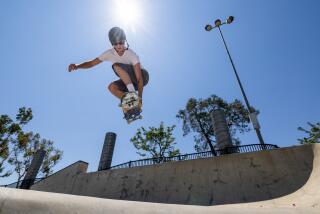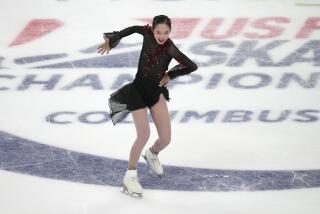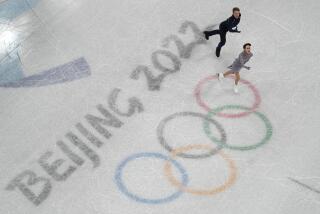Math Majors Should Delight
- Share via
KYOTO, Japan — Ladies and gentlemen, start your calculators.
With cries for reform filling their posh meeting room, delegates to the International Skating Union Congress heard an array of proposals today designed to restore the integrity figure skating has lost since the Salt Lake City Olympic judging scandal.
Presentations made by the U.S., Australia, Canada and the ISU described a dizzying variety of alterations to the scoring and judging systems, but there was no consensus on the form or extent of such changes.
Although ISU President Ottavio Cinquanta vowed “next season the rules will be different than the ones we have today in the book,” most participants were cautious in assessing the merits of the proposals.
“At this moment, there are more questions than answers,” said Sergei Sviridov of Russia.
No vote was taken this morning, because the host Japanese Skating Federation took delegates on a sightseeing trip. Discussion was to continue Thursday.
“We now have an opportunity and obligation to make the changes necessary to make sure our sport is fair and understandable to everybody,” said Phyllis Howard, president of the U.S. Figure Skating Assn.
The key points of the USFSA proposal are ranking skaters based on a median mark, and selecting judges from five geographical zones to guard against cultural bias. Judges would be required to justify their evaluations.
A computer would randomly select seven of 10 judges’ marks for each skater or pair. To obtain a median mark, each judge’s scores would be added to get a total. A computer would weight the first mark in the short program and the second mark in the long program. The high and low total scores would be eliminated to determine the median.
Each portion of the proposal will be evaluated separately, leaving open the possibility of compromise.
Using the median mark, USFSA Executive Director John LeFevre said, “will make it very difficult for one or more judges to be acting in bad faith.”
Sviridov said he liked the U.S. proposal, but Wolfgang Kunz of Germany thought it too imprecise. “I don’t see any reason to change the calculating system to the USFSA way,” he said.
Australia proposed having each event judged by 14 judges, but only nine scores, randomly selected by computer, would count toward the final score. The two highest and two lowest marks would be deleted in the short and long programs. The remaining marks would be displayed on the scoreboard in the arena. In each program, the technical marks would be added to the presentation marks to calculate a final score.
“It is simple, clear and easily understood by everybody....,” said Don McKnight, president of Ice Skating Australia. “The system practically inhibits any kind of possible deals or influences among the judges.”
The ISU proposal is by far the most radical.
In its current form--which is subject to change--judges using computer touchpads would give skaters points based on a scale of merit determined by ISU experts. For example, values could be set at 4.0 for a triple toe loop, 4.4 for a triple salchow, 1.4 for a sit spin, etc. Judges would also add points for a move done well or subtracting for flaws.
Judges would give a second mark for basic skills and presentation skills, using a scale of 0.1 to 6.0. The technical and presentation scores would be added to compute a final score.
The proposal was greeted with many questions, but it had support.
“The fact that evaluations are put on different elements is good,” said Morry Stillwell of the U.S., chairman of the Grand Prix Management Commission.
However, other delegates expressed doubt.
Canada backed the ISU initiative but suggested an interim system while the ISU system is developed.
Canada’s plan called for a random draw of 14 judges and use of only nine marks and ordinals to calculate the final result. The marks would not be made public.
More to Read
Go beyond the scoreboard
Get the latest on L.A.'s teams in the daily Sports Report newsletter.
You may occasionally receive promotional content from the Los Angeles Times.







